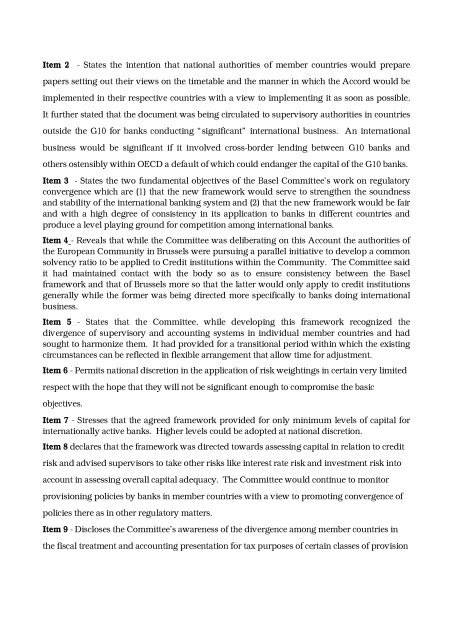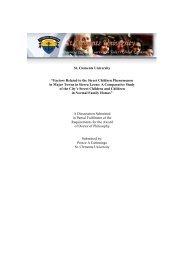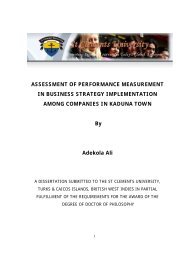Rufus Folorunso Akinyooye - St Clements University
Rufus Folorunso Akinyooye - St Clements University
Rufus Folorunso Akinyooye - St Clements University
Create successful ePaper yourself
Turn your PDF publications into a flip-book with our unique Google optimized e-Paper software.
Item 2 - <strong>St</strong>ates the intention that national authorities of member countries would prepare<br />
papers setting out their views on the timetable and the manner in which the Accord would be<br />
implemented in their respective countries with a view to implementing it as soon as possible.<br />
It further stated that the document was being circulated to supervisory authorities in countries<br />
outside the G10 for banks conducting “significant” international business. An international<br />
business would be significant if it involved cross-border lending between G10 banks and<br />
others ostensibly within OECD a default of which could endanger the capital of the G10 banks.<br />
Item 3 - <strong>St</strong>ates the two fundamental objectives of the Basel Committee’s work on regulatory<br />
convergence which are (1) that the new framework would serve to strengthen the soundness<br />
and stability of the international banking system and (2) that the new framework would be fair<br />
and with a high degree of consistency in its application to banks in different countries and<br />
produce a level playing ground for competition among international banks.<br />
Item 4 - Reveals that while the Committee was deliberating on this Account the authorities of<br />
the European Community in Brussels were pursuing a parallel initiative to develop a common<br />
solvency ratio to be applied to Credit institutions within the Community. The Committee said<br />
it had maintained contact with the body so as to ensure consistency between the Basel<br />
framework and that of Brussels more so that the latter would only apply to credit institutions<br />
generally while the former was being directed more specifically to banks doing international<br />
business.<br />
Item 5 - <strong>St</strong>ates that the Committee, while developing this framework recognized the<br />
divergence of supervisory and accounting systems in individual member countries and had<br />
sought to harmonize them. It had provided for a transitional period within which the existing<br />
circumstances can be reflected in flexible arrangement that allow time for adjustment.<br />
Item 6 - Permits national discretion in the application of risk weightings in certain very limited<br />
respect with the hope that they will not be significant enough to compromise the basic<br />
objectives.<br />
Item 7 - <strong>St</strong>resses that the agreed framework provided for only minimum levels of capital for<br />
internationally active banks. Higher levels could be adopted at national discretion.<br />
Item 8 declares that the framework was directed towards assessing capital in relation to credit<br />
risk and advised supervisors to take other risks like interest rate risk and investment risk into<br />
account in assessing overall capital adequacy. The Committee would continue to monitor<br />
provisioning policies by banks in member countries with a view to promoting convergence of<br />
policies there as in other regulatory matters.<br />
Item 9 - Discloses the Committee’s awareness of the divergence among member countries in<br />
the fiscal treatment and accounting presentation for tax purposes of certain classes of provision
















